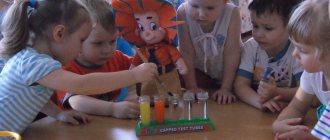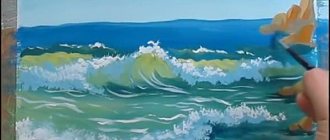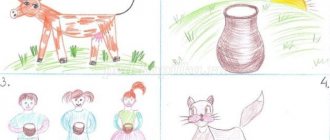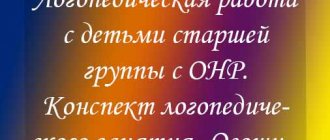Creative project “What the stones say”
- April 3, 2014
Conference “Project activity in an educational institution - 2014”
Nomination “Pedagogical project in a preschool institution”
I tried to find an interesting educational topic, to create conditions for understanding the ways of active interaction of children with inanimate nature and the ancient world history of stone sculptures, the ethnic culture of our region.
We live in a small, beautiful taiga town where iron ore is mined; in fact, we are walking through treasure with our feet. Every time we walked with the children and found different interesting stones, we collected them and brought them to the group, and this is how we got a collection of stones. But over time, it grew into a mini-museum of the history of ancient stones - megaliths, menhirs of Khakassia.
Goal: Creating conditions for the formation of prerequisites for search activities through the implementation of the mini-museum project “What the Stones Say.” Introducing children to the culture of the Khakass people with menhirs, the variety of stones in nature, their features, properties, meaning and use by humans through play and experimental activities.
Tasks:
- Develop research skills. Develop the ability to identify the materials from which stone products are made.
- Enrich the vocabulary of preschoolers.
- To form moral and patriotic feelings for the native land, pride in the cultural and historical heritage.
- Foster a caring attitude towards natural resources.
- To develop interest in objects of inanimate nature and in experimental activities with them.
The first stage is preparatory.
Studying literature, familiarizing with Internet resources, developing a long-term plan. Working with parents.
The second stage is practical.
We collected exhibits for a mini-museum and attracted teachers and children from other groups. Joint activities were carried out through the integration of educational areas. Organization of an exhibition of books: encyclopedias, fiction on the topic of the project. Design of photo albums: “What kind of stones are there”, “What are the stones talking about”. Compilation of the literary collection “Tales of Stones”. Production of attributes for role-playing games.
The third stage is the creation of a mini-museum.
- Design of a mini-museum.
- Presentation of mini-museum exhibits to children of other groups.
The fourth stage is generalizing.
- Creation of an electronic photo album.
- Design of the project and its presentation at the pedagogical council.
As a result of working on the project, the children’s cognitive activity increased. They learned about the properties of stones, their features, meaning and use by humans, about the mineral resources of Russia and Khakassia. The children got acquainted with the culture and way of life of the Khakass people, found out that the Khakass created menhirs for ritual ceremonies and treatment for various ailments. The vocabulary of preschoolers has expanded, the children have learned to look for answers to questions of interest on their own. The degree of parental participation in the life of the group has increased.
Conditions of implementation. This project is carried out on the basis of the MBDOU “TsRR - DS “Dolphin” in a preparatory group for school under the guidance of the teacher of this group. The project is implemented in the joint activities of children, teachers and parents, as well as in the independent activities of each project participant.
Project type: creative, group.
Duration: 4 months.
Appendix: Creative project “What the stones say.”
Author: Nina Vladimirovna Zolotukhina, teacher of the highest qualification category, Child Development Center - Kindergarten "Dolphin", Abaza, Khakassia.
Experiments with stones senior group (5-6 years old)
Principles of preschool education (FSES DO):
1) full-fledged experience by the child of all stages of childhood (infancy, early and preschool age), enrichment (amplification) of child development;
2) building educational activities based on the individual characteristics of each child, in which the child himself becomes active in choosing the content of his education, becomes a subject of education (hereinafter referred to as individualization of preschool education);
3) assistance and cooperation of children and adults, recognition of the child as a full participant (subject) of educational relations;
4) supporting children’s initiative in various activities;
5) cooperation of the Organization with the family;
6) introducing children to sociocultural norms, traditions of the family, society and state;
7) formation of cognitive interests and cognitive actions of the child in various types of activities;
 age adequacy of preschool education (compliance of conditions, requirements, methods with age and characteristics of activity;
age adequacy of preschool education (compliance of conditions, requirements, methods with age and characteristics of activity;
9) taking into account the ethnocultural situation of children’s development.
Educational and methodological kit:
Federal state educational standard for preschool education. / Ministry of Education and Science of the Russian Federation, order No. 1155 of October 17, 2013.
Approximate basic educational program for preschool education P 56 “Paths” / ed. V.T. Kudryavtseva. M.: Ventana-Graf, 2014
Environmental education of preschool children. Experiments with water [Electronic resource]: For preschoolers. — 2015.
Principles of preschool education (FSES):
A child’s full experience of all stages of childhood, enrichment of all stages of child development; building educational activities based on the individual characteristics of each child; recognition of the child as a full participant in educational relations; formation of the child’s cognitive actions; age adequacy of preschool education.
Principles of education:
Creating a positive emotional uplift, developing a personal style of relationships with peers and teachers.
Principles of training:
the principle of visibility, the principle of accessibility, the principle of activity (include children in active activities).
Education methods:
conversation, encouragement.
Teaching methods:
conversation, demonstration, stimulation with entertaining content
Speech development methods:
Verbal
(
conversation), practical (exercise)
Equipment: Water container, stones, napkins, spoons, cups with chopsticks 6 cm long
| Stage, tasks | Methods | Activities of a teacher | Children's activities | Planned result |
2. The science that studies the physical and optical properties of precious stones is called gemology.
3. Absolutely all precious stones are mined by hand.
4. Prices for precious stones will only increase, because there are fewer and fewer real minerals on the planet.
5. 9/10 of all mined diamonds are used for production needs, and only 1/10 reaches jewelers and then consumers.
DIAMOND
6. Precious stones are quite complex in structure, with the exception of diamond. It is based on only one chemical element - carbon.
7. Depending on the shape of the diamond crystal, 55-70% of its weight is lost during processing.
8. The largest natural diamond ever found on our planet is the Cullinan diamond. Before division, its mass was 3106.75 carats (621.35 grams). In 1908, it was split into several large pieces, from which 9 large and 96 small diamonds were eventually made.
9. In 1694, Italian scientists John Averani and C. A. Tardgioni, while trying to fuse several small diamonds into one large one, discovered that when heated strongly, the diamond burned like coal.
10. Diamond will gradually transform into graphite if it is placed in a vacuum or in an inert gas at elevated temperatures.
ALEXANDRITE
11. Alexandrite is one of the few stones that changes its color. From green or blue (in daylight and sunlight) it becomes red or pinkish (in artificial light). Some garnets and sapphires behave in the same way.
12. Alexandrite was named after Tsarevich Alexander, the future Emperor Alexander II.
13. Different peoples of the world, living in different eras, treated emerald differently, but with equal respect. The ancient Greeks came up with a poetic name for it - the stone of radiance. Ancient Russians considered it one of the symbols of wisdom.
14. Indians traditionally presented emerald to newlyweds as a wedding gift, as they believed that it kept the spouses’ feelings “fresh” longer. 1
15. Emerald has long been considered a stone that protects its owner from damage. But our ancestors believed that it could only fully demonstrate these properties in a gold frame.
RUBIES
16.Ruby is considered a very rare and expensive stone.
17. At the same time, there is an entire ruby rock on the planet! It is located in Yakutia, but this huge thing may not be visible to the naked eye. The fact is that the rock is made up of tiny ruby crystals, which can only be distinguished under a microscope.
18. Ruby is a deep scarlet colored gemstone found almost everywhere. The only continent where its deposits have never been discovered is Antarctica.
19.95% of all rubies are artificially refined. Only truly large and perfectly beautiful stones can avoid such a fate.
20. Rubies and sapphires are the same stones. The only difference between them is the color. Rubies and sapphires are a variety of corundum. Red corundums are called rubies, blue ones are called sapphires.
21.The red color of ruby is given by an admixture of chromium, and the blue color of sapphire is caused by the presence of impurities of titanium and iron.
22.Traditionally, these stones are exported from Thailand, Tajikistan, Sri Lanka, Kenya and Tanzania. Rubies from Asia are considered the highest quality and, accordingly, the most expensive.
23. It is no coincidence that ruby is considered the royal stone. He was worshiped by many historical figures. Cleopatra, Cardinal Richelieu, Mary Stuart and Marie de Medici had their own collections of rubies.
24. And our contemporary - British Queen Elizabeth II - in 1973 ordered a luxurious ruby tiara from court jewelers. The jewelry was made from stones given to her by the Burmese as a wedding gift. And the entire jewelry collection of Queen Elizabeth II of England costs about $57 million.
EMERALD
25. Large, defect-free emeralds of a dense tone weighing from 5 carats are valued more than diamonds.
26. The largest emerald crystal was mined in 1974 in Brazil, its weight was 28 kilograms.
27. Aquamarine and emerald are the same stone, just the admixture of different chemical elements gives different colors. Chrome turns emerald green, and aluminum turns aquamarine blue.
28. Almost all emeralds have cracks and inclusions (according to various sources, 90–95%). But this does not reduce their value, because the stone is evaluated by color and saturation.
29. To extract just one carat of emerald, about 20 tons of soil are dug up in mines in Colombia.
30.The term "ornamental stone" refers to minerals and rocks that are used as inserts in jewelry or for the production of stone-cutting products. Sometimes less valuable or opaque stones are called ornamental.
GEMS
31. Gems are precious, semi-precious and ornamental stones that are used as jewelry and ornamental raw materials. They are usually transparent or translucent.
32. Sapphire is usually represented as a deep blue stone. In fact, purple, pink, orange, yellow and even green sapphires are found in nature, and are collectively known as “fancy” sapphires. The only color not available to this stone is red.
33. Boris Godunov valued sapphires very much. He considered them magical, with many beneficial properties.
34. Many people mistakenly believe that diamonds are only colorless. In fact, the color palette of a diamond can be the envy of any precious mineral. But nowadays, not all colored diamonds have natural color. Many stones are artificially colored. This is due to their rarity.
35.Before the invention of the Mohs scale (mineralogical hardness scale), stones were identified by color. So all the green stones became emeralds, the red ones became rubies, etc.
BLUE TOPAZ
36. Topaz becomes dull and discolored in the sun. Therefore, jewelry containing this stone is not recommended to be worn on the beach.
37. Of the colored topazes, the rarest is pink. It is very difficult to extract such stones.
38. And the most fashionable topaz is a delicate pinkish-powdery shade of Misty Rose.
39. In order to distinguish a real diamond from its imitation, a special “diamond probe” is used to measure the thermal conductivity of the stone being examined. Diamond has a much higher thermal conductivity value than its substitutes.
40. In addition, the good wettability of the diamond with fat is used: a felt-tip pen filled with special ink leaves a solid line on the surface of the diamond, while on the surface of the imitation it crumbles into separate droplets.
BIXBIT
41. There is a “red emerald” stone. In fact, it is a red variety of beryl, bixbite. This is an extremely rare stone and is mined only in Utah (USA).
42. Pink topaz is the rarest colored variety of this gemstone. It is pink topazes that are most often counterfeited.
TANZANITE
43. The largest known topaz is called Eldorado topaz. The weight of the stone, stored in Brazil, is 31 thousand carats.
44. If opals are stored in low humidity conditions, loss of moisture may cause them to crack and become cloudy. Therefore, jewelry and jewelry with opals should be worn as often as possible, since the gemstone can take the moisture it needs from the air or the skin of the person who wears it.
45. Cubic zirconia, an artificial material that imitates a diamond, is widely used in jewelry. Its cultivation occurs in laboratory conditions, where the crystal growth rate is up to 8-10 mm/h.
AMBER
46. Amber is the name of the resin of coniferous trees, which has lain in the depths for about 30,000,000 years.
47. Amber in the open air actively oxidizes (aging), which over time leads to changes in the chemical composition, color and increased fragility.
48. The largest amber deposit is the Kaliningrad region. The amber plant in the village of Yantarny produces about 90% of the world's production of this stone.
KREMLIN RUBY STARS
49. The Kremlin stars were originally made from Ural gems, which did not stand the test of time and harsh Moscow weather conditions and became dim.
50. In 1937, the Soviet government decided to install new stars - resistant to temperature changes, durable and not losing their color. A talented master, specialist glassmaker Nikanor Kurochkin compiled a recipe according to which a special glass was welded - ruby. It was from this that the shining red stars that decorated the Kremlin towers were made.
photo from the Internet




